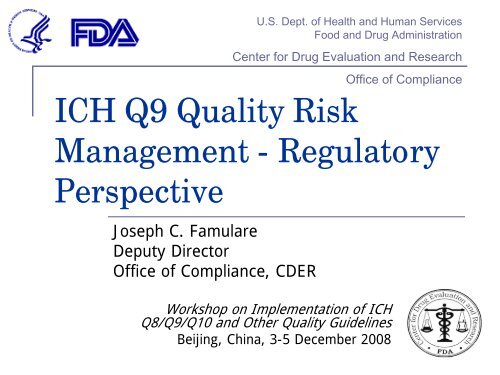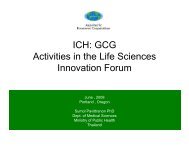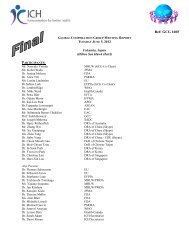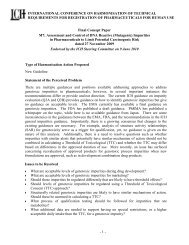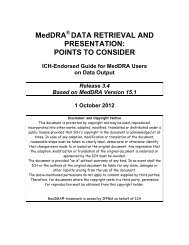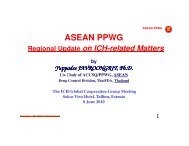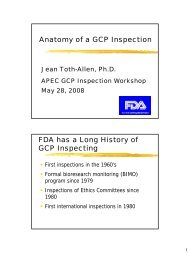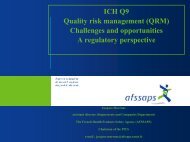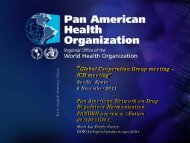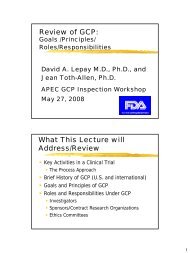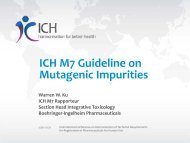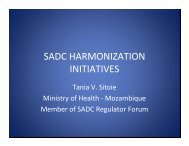ICH Q9 - Regulatory Perspective
ICH Q9 - Regulatory Perspective
ICH Q9 - Regulatory Perspective
You also want an ePaper? Increase the reach of your titles
YUMPU automatically turns print PDFs into web optimized ePapers that Google loves.
U.S. Dept. of Health and Human Services<br />
Food and Drug Administration<br />
Center for Drug Evaluation and Research<br />
<strong>ICH</strong> <strong>Q9</strong> Quality Risk<br />
Office of Compliance<br />
Management - <strong>Regulatory</strong><br />
<strong>Perspective</strong><br />
Joseph C. Famulare<br />
Deputy Director<br />
Office of Compliance, CDER<br />
Workshop on Implementation of <strong>ICH</strong><br />
Q8/<strong>Q9</strong>/Q10 and Other Quality Guidelines<br />
Beijing, China, 3-5 December 2008
U.S. DHHS, FDA, CDER Office of Compliance<br />
Objectives<br />
• Background<br />
• Review of Guideline<br />
• Applications<br />
• Conclusions<br />
Quality Risk Management<br />
A systematic process for the<br />
assessment, control, communication<br />
and review of risks to the quality of<br />
the drug (medicinal) product across<br />
the product lifecycle.<br />
2
BACKGROUND<br />
U.S. DHHS, FDA, CDER Office of Compliance<br />
What is <strong>Q9</strong>?<br />
• A new paradigm of riskbased<br />
concepts and<br />
principles<br />
• A guideline, not a<br />
mandate<br />
“risk-based”<br />
concepts<br />
and<br />
principles<br />
• A systemic, processoriented<br />
approach to<br />
decision making that is<br />
intended to be<br />
<br />
<br />
<br />
<br />
<br />
practical,<br />
applicable,<br />
predictive,<br />
flexible,<br />
consistent and integrated<br />
Q8<br />
<strong>Q9</strong><br />
Q10<br />
3
BACKGROUND<br />
U.S. DHHS, FDA, CDER Office of Compliance<br />
What is <strong>Q9</strong>?<br />
• The <strong>ICH</strong> <strong>Q9</strong> document:<br />
Main body explains the “What?”<br />
Annex (I) give ideas on the “How?”<br />
Annex (II) give ideas on the “Where?”<br />
• It is designed to be implemented by industry<br />
and regulators<br />
Pharmaceutical development (<strong>ICH</strong> Q8) and Quality<br />
Systems (<strong>ICH</strong> Q10) will facilitate the “What?”,<br />
“How?” and “Where?”<br />
4
BACKGROUND<br />
U.S. DHHS, FDA, CDER Office of Compliance<br />
Goal is to reduce patient risk<br />
Design<br />
Opportunities to impact<br />
risk using quality risk<br />
management <strong>Q9</strong><br />
Process<br />
Materials<br />
Manufacturing<br />
Facilities<br />
Distribution<br />
Q8<br />
Q10<br />
Patient<br />
5
BACKGROUND<br />
U.S. DHHS, FDA, CDER Office of Compliance<br />
What does <strong>Q9</strong> offer?<br />
• Quality risk management serves as a<br />
foundation to<br />
support other <strong>ICH</strong> Quality documents and<br />
complement best quality practices, requirements,<br />
standards, and guidelines within industry and<br />
regulators.<br />
• It specifically provides guidance on the<br />
principles and some of the tools of quality<br />
risk management to enable consistent risk<br />
based decisions across the product lifecycle.<br />
6
BACKGROUND<br />
U.S. DHHS, FDA, CDER Office of Compliance<br />
The Desired State<br />
• Manage risk to patient, based on<br />
science:<br />
<br />
<br />
<br />
Product, process and facility<br />
Robustness of Quality System<br />
Relevant controls to assess &<br />
mitigate risk<br />
• Level of oversight required<br />
commensurate with the level of<br />
risk to patient for:<br />
<br />
<br />
<br />
Marketing authorisation<br />
applications<br />
Post-approval change review<br />
GMP inspections<br />
• Barriers to continuous<br />
improvement<br />
reduced or removed<br />
<br />
<br />
Improved manufacturing<br />
efficiency<br />
Sustained or improved product<br />
quality<br />
• Specifications based on<br />
parameters<br />
that truly impact product quality<br />
• Common understanding and<br />
language on risk<br />
• Both, industry and competent<br />
authorities focus on areas of<br />
greatest risk and understanding<br />
of residual risks<br />
7
GUIDELINE<br />
U.S. DHHS, FDA, CDER Office of Compliance<br />
<strong>Q9</strong> Contents<br />
• 1. Introduction<br />
• 2. Scope<br />
• 3. Principles of Quality Risk Management (QRM)<br />
• 4. General Quality Risk Management Process<br />
• 5. Risk Management Methodology<br />
Annex I: Risk Management Methods and Tools<br />
• 6. Integration of QRM process<br />
into Industry and <strong>Regulatory</strong> operations<br />
Annex II: Potential Applications for QRM<br />
• 7. Definitions<br />
• 8. References<br />
8
GUIDELINE<br />
U.S. DHHS, FDA, CDER Office of Compliance<br />
1. Introduction<br />
• Terms<br />
<br />
<br />
<br />
<br />
<br />
<br />
<br />
<br />
Risk Management<br />
Quality Risk Management<br />
Quality Systems<br />
Harm<br />
Severity<br />
Stakeholder<br />
Product Life Cycle<br />
GMP Compliance<br />
• Purpose<br />
<br />
<br />
<br />
Systematic approach<br />
Complementary resource<br />
Provides principles and<br />
tools<br />
9
GUIDELINE<br />
U.S. DHHS, FDA, CDER Office of Compliance<br />
2. Scope - Product Lifecycle<br />
Research<br />
Preclinical<br />
Phase<br />
Clinical<br />
Phases<br />
Launch<br />
Manufacturing<br />
& Distribution<br />
GLP<br />
Safety<br />
GCP<br />
GMP<br />
GDP<br />
Efficacy<br />
<strong>ICH</strong> <strong>Q9</strong><br />
Quality<br />
10
GUIDELINE<br />
U.S. DHHS, FDA, CDER Office of Compliance<br />
3. Principles<br />
• The evaluation of the<br />
risk to quality should<br />
be based on scientific<br />
knowledge and<br />
ultimately link back to<br />
the protection of the<br />
patient.<br />
• The level of effort,<br />
formality, and<br />
documentation of the<br />
quality risk management<br />
process should be<br />
commensurate with the<br />
level of risk.<br />
11
GUIDELINE<br />
U.S. DHHS, FDA, CDER Office of Compliance<br />
4. General Process<br />
Initiate<br />
Quality Risk Management Process<br />
Risk Assessment<br />
Risk Identification<br />
Risk Analysis<br />
Risk Communication<br />
Risk Control<br />
Risk Evaluation<br />
Risk Reduction<br />
Risk Acceptance<br />
Output / Result of the<br />
Quality Risk Management Process<br />
unacceptable<br />
Risk Management Tools<br />
Risk Review<br />
Review Events<br />
12
GUIDELINE<br />
U.S. DHHS, FDA, CDER Office of Compliance<br />
5. Methodology<br />
• System Risk (facility & people)<br />
<br />
e.g., interfaces, operators risk, environment,<br />
components such as equipment, IT, design elements<br />
• System Risk (organisation)<br />
<br />
e.g., Quality systems, controls, measurements,<br />
documentation, regulatory compliance<br />
• Process Risk<br />
<br />
e.g., process operations and quality parameters<br />
• Product Risk (safety & efficacy)<br />
<br />
e.g., quality attributes: measured data according to<br />
specifications<br />
13
GUIDELINE<br />
U.S. DHHS, FDA, CDER Office of Compliance<br />
5. Annex I: Risk Assessment Tools<br />
Failure Mode & Effects Analysis (FMEA)<br />
Failure Mode, Effects and Criticality Analysis<br />
(FMECA)<br />
Fault Tree Analysis (FTA)<br />
Hazard Analysis of Critical Control Points (HACCP)<br />
Hazard Operability Analysis (HAZOP)<br />
Preliminary Hazard Analysis (PHA)<br />
Risk ranking and filtering<br />
Refer to: <strong>ICH</strong> <strong>Q9</strong> Briefing Pack II, July 2006<br />
http://www.ich.org/cache/compo/276-254-1.html<br />
14
GUIDELINE<br />
U.S. DHHS, FDA, CDER Office of Compliance<br />
6. Integration into Operations<br />
• Quality risk management is intended to<br />
enable and enhance compliance with<br />
regulatory requirements and science-based<br />
decisions when integrated into quality<br />
systems<br />
• It is also meant to be applied where it is<br />
feasible and valuable<br />
15
GUIDELINE<br />
U.S. DHHS, FDA, CDER Office of Compliance<br />
6. Integration into Lifecycle<br />
Gain experience<br />
Analyse root cause:<br />
Continual<br />
improvement<br />
(Risk of) Failure ?<br />
Manufacture<br />
Improve it<br />
Quality Risk<br />
Management<br />
(QRM)<br />
Do, what you say<br />
Update<br />
information<br />
Approval<br />
Say, what you do<br />
16
GUIDELINE<br />
U.S. DHHS, FDA, CDER Office of Compliance<br />
6. Annex II: Potential Applications<br />
Integrated quality management<br />
<strong>Regulatory</strong> operations<br />
Development<br />
Facilities, equipment, utilities<br />
Materials management<br />
Production<br />
Laboratory control and stability studies<br />
Packaging and labeling<br />
Refer to: <strong>ICH</strong> <strong>Q9</strong> Briefing Pack II, July 2006<br />
http://www.ich.org/cache/compo/276-254-1.html<br />
17
APPLICATIONS<br />
U.S. DHHS, FDA, CDER Office of Compliance<br />
Applies to Regulators & Industry<br />
• <strong>Regulatory</strong><br />
operations<br />
<br />
<br />
Inspection and<br />
assessment<br />
activities<br />
Internal systems<br />
• Industry operations<br />
(with regulatory oversight)<br />
<br />
<br />
<br />
<br />
<br />
<br />
<br />
Internal systems<br />
Development<br />
Facilities, equipment, utilities<br />
Materials management<br />
Production<br />
Laboratory control, stability testing<br />
Packaging and labelling<br />
18
APPLICATIONS<br />
U.S. DHHS, FDA, CDER Office of Compliance<br />
Q8 Pharmaceutical Development<br />
• Development studies lead to information for<br />
risk management of the product<br />
• Risk management principles help prioritize<br />
development studies<br />
• Information relating to process in<br />
development supports risk management in<br />
manufacturing<br />
19
APPLICATIONS<br />
U.S. DHHS, FDA, CDER Office of Compliance<br />
Q8(R1)“Quality by Design”<br />
• Link material attributes and process<br />
parameters to critical quality attributes<br />
Identify and rank parameters, e.g., process,<br />
equipment, materials<br />
• Selection of variable within the design space<br />
Identify variables and ranges Scale-up risks<br />
• Control strategy<br />
Compensate for variability, e.g., raw materials<br />
20
APPLICATIONS<br />
U.S. DHHS, FDA, CDER Office of Compliance<br />
Q8(R1) Variables & quality attribute<br />
Drying<br />
Analytical<br />
Temp<br />
RH<br />
Air Flow<br />
Sampling<br />
Precompressing<br />
Shock Cycle<br />
Water<br />
Drug<br />
Substance<br />
Method<br />
Water<br />
Tablet<br />
Content<br />
Temp/RH<br />
Main Compressing<br />
Binder<br />
Age<br />
Operator<br />
Training<br />
Feeder Speed<br />
Press Speed<br />
Punch Penetration<br />
Depth<br />
Spray Rate<br />
Spray Pattern<br />
Temp<br />
P.S.<br />
Process Conditions<br />
Diluents<br />
LOD<br />
Plant<br />
Factors<br />
Tooling<br />
Feed<br />
Frame<br />
Scrape Down<br />
P.S.<br />
P.S.<br />
LOD<br />
Compressing<br />
Chopper Speed<br />
Mixer Speed<br />
Other<br />
Lubricant<br />
Endpoint<br />
Disintegrant<br />
Raw<br />
Power<br />
Granulation<br />
Binder<br />
Materials<br />
Time<br />
21
U.S. DHHS, FDA, CDER Office of Compliance<br />
<strong>ICH</strong> Q10 Pharmaceutical Quality System<br />
Pharmaceutical<br />
Development<br />
Technology<br />
Transfer<br />
Commercial<br />
Manufacturing<br />
Product<br />
Discontinuation<br />
Investigational products<br />
GMP<br />
PQS<br />
elements<br />
Management Responsibilities<br />
Process Performance & Product Quality Monitoring System<br />
Corrective Action & Preventive Action (CAPA) System<br />
Change Management System<br />
Management Review<br />
Enablers<br />
Knowledge Management<br />
Quality Risk Management<br />
22
APPLICATIONS<br />
U.S. DHHS, FDA, CDER Office of Compliance<br />
Q10 Pharmaceutical Quality System<br />
• Documentation<br />
• Training and education<br />
• Outsourced activities / purchased materials<br />
• Control Strategy<br />
<br />
Use quality risk management to establish using parameters<br />
and attributes and related facility and equipment operating<br />
conditions<br />
• Monitoring / Handling Quality Defects (CAPA)<br />
<br />
<br />
The level of effort of the investigation should be<br />
commensurate with the level of risk.<br />
Result should be product and process improvements<br />
23
U.S. DHHS, FDA, CDER Office of Compliance<br />
Q10 Pharmaceutical Quality System<br />
• Auditing / Inspection<br />
For regulators<br />
For companies<br />
• Periodic review<br />
• Change management / change control<br />
Level and formality commensurate with risk<br />
• Effect of the change on the overall process and product<br />
• Effect on validation<br />
• Evaluation of the change upon implementation<br />
• Continual improvement<br />
24
APPLICATIONS<br />
U.S. DHHS, FDA, CDER Office of Compliance<br />
Risk Assessment<br />
[Reference: J Pharm Innov (2008) 3:79–87 | DOI 10.1007/s12247-008-9034-2 | “PQLI Design Space” J.Lepore & J.Spavins]<br />
25
APPLICATIONS<br />
U.S. DHHS, FDA, CDER Office of Compliance<br />
Risk Assessment, Non-quantitative<br />
[Reference: J Pharm Innov (2008) 3:79–87 | DOI 10.1007/s12247-008-9034-2 | “PQLI Design Space” J.Lepore & J.Spavins]<br />
26
APPLICATIONS<br />
U.S. DHHS, FDA, CDER Office of Compliance<br />
Industry Example<br />
27
APPLICATIONS<br />
U.S. DHHS, FDA, CDER Office of Compliance<br />
Industry Example<br />
28
APPLICATIONS<br />
U.S. DHHS, FDA, CDER Office of Compliance<br />
<strong>Regulatory</strong> Operations: FDA<br />
• Site selection process for human drug GMP<br />
inspections<br />
• Veterinary drug pre-approval decision<br />
support system (PAIDSS)<br />
• Adverse Drug Event (ADE) reporting<br />
inspections<br />
• Human drug surveillance sampling programs<br />
29
APPLICATIONS<br />
U.S. DHHS, FDA, CDER Office of Compliance<br />
FDA Site Selection Risk Model (2008-09)<br />
Facility Size<br />
Recalls<br />
Last 3 District<br />
Decisions<br />
Establishment<br />
Type<br />
Time since Last<br />
CGMP Inspection<br />
Unapproved Drugs<br />
Therapeutic Class<br />
Control<br />
Contamination<br />
Facility<br />
Outdated<br />
Information<br />
Product<br />
Process<br />
Score Score (SRP) (SRP)<br />
30
CONCLUSIONS<br />
U.S. DHHS, FDA, CDER Office of Compliance<br />
Goals and Conclusions<br />
• Use of Risk Management Tools Provide Basis<br />
for:<br />
Development and Design<br />
Degree of <strong>Regulatory</strong> Scrutiny<br />
Control of Manufacturing Process and change<br />
control justified by science - and - in the hands of<br />
the manufacturer<br />
31
CONCLUSIONS<br />
U.S. DHHS, FDA, CDER Office of Compliance<br />
Management Responsibilities<br />
• Ensure organisation is aware of <strong>ICH</strong> <strong>Q9</strong><br />
and the opportunity it affords<br />
<br />
Appropriate education and training<br />
• Encourage open, risk aware culture<br />
<br />
Establish & support “QRM leaders” across organisations<br />
• Encourage integration of Quality Risk Management<br />
with existing Quality systems<br />
<br />
<br />
<br />
Do NOT set up as a separate department<br />
Coordinate implementation and resource allocation<br />
Prioritise; start small, learn as you go<br />
32
CONCLUSIONS<br />
U.S. DHHS, FDA, CDER Office of Compliance<br />
Opportunity<br />
• <strong>ICH</strong> <strong>Q9</strong>, together with “Pharmaceutical<br />
development” [<strong>ICH</strong> Q8, Q8(R1)] and “Quality<br />
systems” [<strong>ICH</strong> Q10], provides opportunity for a<br />
revised, optimised and, less restrictive regulatory<br />
paradigm<br />
<br />
<br />
<br />
<br />
<br />
Based on scientific knowledge<br />
Enables continual improvement<br />
Greater transparency and efficiency<br />
Focusing on things that add value for patients<br />
Improved relationship between industry and competent<br />
authorities based on trust<br />
33


